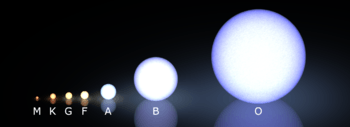HD 129357
| Observation data Epoch J2000 Equinox J2000 | |
|---|---|
| Constellation | Boötes |
| Right ascension | 14h 41m 22.390s[1] |
| Declination | +29° 03′ 31.80″[1] |
| Apparent magnitude (V) | 7.823[2] |
| Characteristics | |
| Spectral type | G2V[3] |
| U−B color index | +0.115[3] |
| B−V color index | +0.635[3] |
| Astrometry | |
| Radial velocity (Rv) | −33.2[2] km/s |
| Proper motion (μ) | RA: +11.76[4] mas/yr Dec.: −183.50[4] mas/yr |
| Parallax (π) | 21.22 ± 1.02[4] mas |
| Distance | 154 ± 7 ly (47 ± 2 pc) |
| Details | |
| Mass | 1.00 ± 0.06[5] M☉ |
| Surface gravity (log g) | 4.16 ± 0.13[5] cgs |
| Temperature | 5,749 ± 47[5] K |
| Metallicity | [Fe/H] = −0.02 ± 0.04[5] |
| Rotational velocity (v sin i) | ≤ 2.5[5] km/s |
| Age | 8.1[2] Gyr |
| Other designations | |
| Database references | |
| SIMBAD | data |
HD 129357 is a G-type star in the constellation Boötes that is located about 154 light years from the Sun. The measured properties of this star are very similar to those of the Sun, making it a candidate solar twin. However, it has a lower abundance of lithium than the Sun and appears over 3 billion years older, so it may instead be a solar analog. It was suggested by astronomer Olin Eggen that this star is a member of the Wolf 630 moving group of stars that share a common motion through space. The space velocity components of HD 129357 are (U, V, W) = (+21.3, −36.3, −32.0).[5]
Sun comparison
This chart compares the Sun to HP 129357.
| Identifier | J2000 Coordinates | Distance (ly) |
Stellar Class |
Temperature (K) |
Metallicity (dex) |
Age (Gyr) |
Notes | |
|---|---|---|---|---|---|---|---|---|
| Right ascension | Declination | |||||||
| Sun | — | — | 0.00 | G2V | 5,778 | +0.00 | 4.6 | [6] |
| HD 129357 [7] | 14h 41m 22.4s | +29° 03′ 32″ | 154 | G2V | 5,749 | −0.02 | 8.1 | [8] |
To date no solar twin with an exact match as that of the Sun has been found, however, there are some stars that come very close to being identical to that of the Sun, and are such considered solar twins by the majority of the public. An exact solar twin would be a G2V star with a 5,778K temperature, be 4.6 billion years old, with the correct metallicity and a 0.1% solar luminosity variation.[9] Stars with an age of 4.6 billion years are at the most stable state. Proper metallicity and size are also very important to low luminosity variation. [10][11][12]

References
- 1 2 Høg, E.; et al. (March 2000). "The Tycho-2 catalogue of the 2.5 million brightest stars". Astronomy and Astrophysics. 355: L27–L30. Bibcode:2000A&A...355L..27H. doi:10.1888/0333750888/2862.
- 1 2 3 Nortdstrom, R.; et al. "The Geneva-Copenhagen survey of the Solar neighbourhood. Ages, metallicities, and kinematic properties of ~14000 F and G dwarfs". Astronomy and Astrophysics. 418: 989–1019. arXiv:astro-ph/0405198
 . Bibcode:2004A&A...418..989N. doi:10.1051/0004-6361:20035959.
. Bibcode:2004A&A...418..989N. doi:10.1051/0004-6361:20035959. - 1 2 3 4 "HD 129357 -- High proper-motion Star". SIMBAD. Centre de Données astronomiques de Strasbourg. Retrieved 2011-01-21.
- 1 2 3 Perryman, M. A. C.; et al. (July 1997). "The HIPPARCOS Catalogue". Astronomy & Astrophysics. 323: L49–L52. Bibcode:1997A&A...323L..49P.
- 1 2 3 4 5 6 King, Jeremy R.; Boesgaard, Ann M.; Schuler, Simon C. (November 2005). "Keck HIRES Spectroscopy of Four Candidate Solar Twins". The Astronomical Journal. 130 (5): 2318–2325. arXiv:astro-ph/0508004
 . Bibcode:2005AJ....130.2318K. doi:10.1086/452640.
. Bibcode:2005AJ....130.2318K. doi:10.1086/452640. - ↑ Williams, D.R. (2004). "Sun Fact Sheet". NASA. Retrieved 2009-06-23.
- ↑ HD 129357 at SIMBAD - Ids - Bibliography - Image.
- ↑ King, Jeremy R.; Boesgaard, Ann M.; Schuler, Simon C. (November 2005). "Keck HIRES Spectroscopy of Four Candidate Solar Twins". The Astronomical Journal. 130 (5): 2318–2325. arXiv:astro-ph/0508004
 . Bibcode:2005AJ....130.2318K. doi:10.1086/452640.
. Bibcode:2005AJ....130.2318K. doi:10.1086/452640. - ↑ NASA, Science News, Solar Variability and Terrestrial Climate, Jan. 8, 2013
- ↑ University of Nebraska-Lincoln astronomy education group, Stellar Luminosity Calculator
- ↑ National Center for Atmospheric Research, The Effects of Solar Variability on Earth's Climate, 2012 Report
- ↑ Most of Earth’s twins aren’t identical, or even close!, by Ethan on June 5, 2013